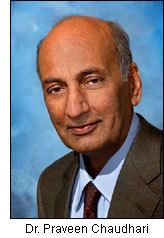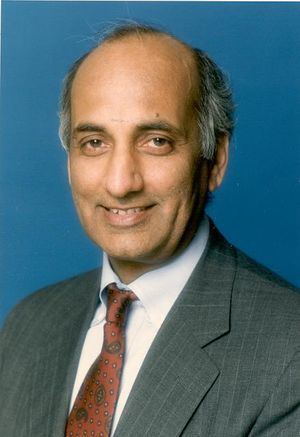Occupation physicist Spouse(s) Karin Praveen | Name Praveen Chaudhari Role Physicist | |
 | ||
Died January 12, 2010, Briarcliff Manor, New York, United States Education Massachusetts Institute of Technology Awards National Medal of Technology and Innovation | ||
Dr. Praveen Chaudhari (November 30, 1937 – January 12, 2010) was an Indian American physicist born in Ludhiana, India, who migrated to the United States in 1961 and contributed to the field of material physics.
Contents

Chaudhari was employed by IBM's Research Division, headquartered at the Thomas J. Watson Research Center in Yorktown Heights, New York after coming to the United States. Praveen researched the structure and properties of amorphous solids, defects in solids, mechanical properties of thin films, superconductivity, quantum transport in disordered systems, liquid crystal alignment on substrates, and the magnetic monopole experiment.
His career with IBM lasted 36 years during which he was appointed director and later vice president of science in 1981 and 1982, until he stepped down as director of Brookhaven National Laboratory (BNL) in 2006, citing his wish to continue with the laboratory as part-time, following President George W. Bush's allowance for increased funding to the department in his budget. Chaudhari had been hailed for successfully navigating BNL through a series of significant funding challenges. In his official statement he had cited his decision that "The laboratory is in very good shape and I feel it is time for me to make a change: to spend more time at home and to take advantage of the wonderful opportunities to do science at BNL."
Praveen died on January 12, 2010, at the age of 72 in his home in Briarcliff Manor, New York, after a long battle with cancer. He is survived by his wife, Karin; his son, Ashok; and his daughter, Pia.
Positions held
Chaudhari held a number of positions, starting as a visiting scientist in 1964 at the Danish Atomic Energy Commission. In 1966, he joined both the Massachusetts Institute of Technology as a research associate and the IBM T.J. Watson Research Center as a research staff member. At IBM, he was promoted to manager in the Physical Sciences department in 1970, followed by various management positions in that decade, including that of co-ordinating the magnetic bubble, optical recording and Josephson technology programs in the physical sciences. In 1974, he became a visiting faculty member at Harvard University in the Division of Engineering and Applied Sciences. In 1980, Chaudhari became the acting director of the Physical Sciences department, followed by his promotion as the director of the Physical Sciences Department in 1981. From 1982 until 1991 he was the vice-president of science, and from 1989 until 1990 he participated as a member of the Corporate Technical Committee. Chaudhari was the founding member of the IBM Academy of Technology in 1990, and throughout this time, beginning in 1966, kept his position as a research staff member at IBM until 2003. From 2003 until 2006, he was the director of the Brookhaven National Laboratory.
Committees
The 14 committees on which Chaudhari served include the Advisory Committee to the National Sciences Association at the University of Pennsylvania, the Visiting Committee to the School of Engineering at the University of Illinois, the Corporation Visiting Committee to the Department of Materials Science and Engineering, at MIT, the Visiting Committee to the Division of Physical Sciences at the University of Chicago, the Overseers' Committee to Visit the Division of Applied Sciences at Harvard University, the Science Policy Board to Stanford Synchrotron Radiation Laboratory in Stanford, California, the Materials Science and Engineering Advisory Committee at the University of California at Berkeley, the New York State Institute of Superconductivity, the ad hoc Visiting Committee, appointed by Provost, to examine the School of Engineering and Applied Science at Columbia University, New York, the Advisory Board of the Texas Center for Superconductivity, University of Houston, the Advisory Committee to the School of Engineering, Georgia Tech, the Physics Policy Committee of the American Physical Society, the Governing Board of the New York Academy of Sciences, the National Science Foundation Advisory Committee to the Mathematical and Physical Sciences, the Scientific Advisory Council of the International Center for Theoretical Physics in Trieste, Italy. He co-chaired the National Research Council Study on Materials Science and Engineering.
Research
As the vice-president of science, Chaudhari became responsible for not only his local science programs at Watson Research Center in Watson, but also the renowned Zurchich Research Laboratory in Switzerland as well as the Almaden Research Center in California.
In addition to directing scientific research at I.B.M., Praveen conducted a fair amount of research and experiments himself. These experiments pertained to topics such as the structure and properties of amorphous solids, defects in solids, mechanical properties of thin films, superconductivity, quantum transport in disordered systems, liquid crystal alignment on substrates, and on the magnetic monopole experiment. He published articles in scientific journals such as Physica C, Technology in Society, and Current Opinion in Solid State Materials Science on his research pertaining to topics such as critical currents, grain boundaries and squids in the high temperature cuprate superconductors, and electronic materials. Amongst his discoveries were amorphous magnetic films in magneto-optic data storage systems for which he received the Morris N. Liebmann Memorial Award in 1992. Also amongst his accomplishments was the discovery of a new class of materials, which were amorphous, magnetic and became the foundation of the worldwide magnetic-optic disc industry. Under his direction at the Brookhaven Laboratory, the four RHIC collaborations found a nearly perfect liquid during a laboratory experiment recreating the conditions believed to have existed a few microseconds after the birth of the universe, and continued to collect and analyze large data sets from the fourth and fifth years of operations.
During his tenure, Chaudhari filed over 22 patents, most notably one for the erasable read-write compact discs which are commonly used to burn music.
Accomplishments
Academically, Chaudhari earned a Bachelor of Science from the Indian Institute of Technology in 1961, a Master of Science from the Massachusetts Institute of Technology in 1963, and a Science Doctorate also from Massachusetts Institute of Technology in 1966.
During his tenure as the Director of the U.S. Department of Energy's Brookhaven National Laboratory, Chaudhari was appointed Director in 1981, and Vice President of Science in 1982. He helped secure funding for the department's flagship facility, and the Relativistic Heavy Ion Collider during trying economic periods. Under Chaudhari, IBM scientists captured Nobel Prizes for Physics in 1986 and 1987.
Chaudhari was a member of scientific institutions such as the National Academy of Engineering, the National Academy of Sciences, the American Academy of Arts and Sciences and the American Physical Society. He was the executive secretary of President Reagan's Advisory Council on Superconductivity and served on the US National Critical Technology Panel.
His awards include the National Medal for Technology, the American Physical Society's George E. Pake Award, the Electrical and Electronics Engineers, Inc., Morris N. Liebmann Memorial Award, the Massachusetts Institute of Technology Harry C. Gatos Distinguished Lecture and Prize, and the National Medal of Technology.
